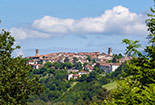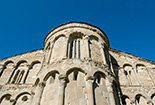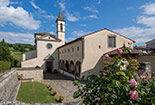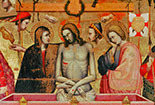The Church of Bibbiena
in Casentino, a Tuscan valley with which you can get familiar in every detail through this site
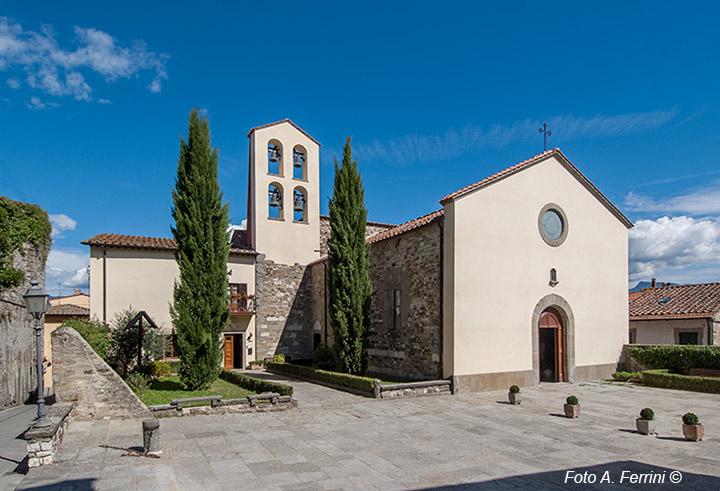
Texts and photos by Alessandro Ferrini ©
48 accurately described images of Pieve of Bibbiena. Click to enlarge
The Parish Church of Bibbiena: a thousand-year old history
 In the historic center of Bibbiena there are three very interesting churches from the historic, architectural and artistic point of view. The most famous and important one is commonly referred to as "Pieve", but this name with which it is called is inaccurate because it stopped being a parish church in 1744 when it became rectory of the village.
In the historic center of Bibbiena there are three very interesting churches from the historic, architectural and artistic point of view. The most famous and important one is commonly referred to as "Pieve", but this name with which it is called is inaccurate because it stopped being a parish church in 1744 when it became rectory of the village.
The history of this sacred building surely is very ancient, it might date back to the 7th century, but little is known of its origins, which anyway are not to be found in the village of Bibbiena, but in a country-place called Castellare, less than a kilometer away from the current church.
In the second half of the 10th century this parish church, dedicated to Saints Ippolito and Cassiano, changed its location and was built in the same place where it is nowadays, which is the highest area of the hill of Bibbiena. From this moment until 1425 this sacred building underwent remakes, destructions, rebuildings and enlargements.
This church of the 10th century was built, as a parish church, outside the castle walls, assuming the castle was already erected. On the contrary, at the end of the 12th century the church was documented being inside the walls of the castle, and was built on a greek cross plan with a Romanesque style.
 The 11th of June 1289 was the day of the bloody Battle of Campaldino, near Poppi, in which the Florentines defeated the inhabitants of Arezzo. In the days following the battle, the army of Florence also took care of destroying both the Castle of Bibbiena and its church because they were properties of Arezzo.
The 11th of June 1289 was the day of the bloody Battle of Campaldino, near Poppi, in which the Florentines defeated the inhabitants of Arezzo. In the days following the battle, the army of Florence also took care of destroying both the Castle of Bibbiena and its church because they were properties of Arezzo.
At the beginning of the 14th century started the rebuilding of Bibbiena and its parish church, still resorting to a Greek cross plan, but with architectural characteristics that showed both the Romanesque and Gothic styles. In 1312 Guido Tarlati was elected bishop of Arezzo, then in 1321 he also became Lord of both the city and Bibbiena. He was very attached to this castle of Casentino; therefore, he gave a significant boost to the rebirth of this area and to the care of its church. But this period of splendor lasted for only a few dacades because, with the deaths of Guido Tarlati in 1327 and of Pier Saccone Tarlati in 1356 (Guido's brother who had succeeded him as Lord of Bibbiena at the moment of his death), this area underwent a quick decay. From a report written in 1424 on the occasion of a pastoral visit by Francesco da Montepulciano, Bishop of Arezzo, the Parish Church of Saints Ippolito and Cassiano was found in a precarious state of preservation and missing parts of the roof.
On this very same Bishop's immediate decision, during the years 1424-1425 the church underwent not only consolidation work, but also an enlargement due to the increasing population size. This expansion was put into place by extending the Greek cross southern branch. From that moment, the parish church got a Latin cross plan. It has kept this new structure and dimension up to the present day.
From the structural point of  view the church we can visit nowadays is the same one built during the 15th century. On the contrary, its artistic aspect has certainly changed. Parts of frescos are visible in certain spots of the wall where the plaster is missing, enabling us to understand that the parish church used to be very decorated. Even if these paintings are now hidden because they were covered by a subsequent plaster, it is also true that during the following centuries the parish church was enriched with other works of art. Today, all this makes the Rectory of Bibbiena a place of high tourist and cultural interest not only for its history, but also because of the valuable works of art preserved there.
view the church we can visit nowadays is the same one built during the 15th century. On the contrary, its artistic aspect has certainly changed. Parts of frescos are visible in certain spots of the wall where the plaster is missing, enabling us to understand that the parish church used to be very decorated. Even if these paintings are now hidden because they were covered by a subsequent plaster, it is also true that during the following centuries the parish church was enriched with other works of art. Today, all this makes the Rectory of Bibbiena a place of high tourist and cultural interest not only for its history, but also because of the valuable works of art preserved there.
Inside the church there are several frescos dating back from the 14th to the 17th century that deserve to be seen: a wooden Madonna with Child of the 13th century, a thirteen-century painted cross, a refined Madonna with Child of Arcangelo Cola from Camerino (painted around 1425), a polyptych of 1435 made by Bicci di Lorenzo representing a Madonna with Child and Saints, a beautiful Annunciation of Giovanni Balducci dated around 1580, and a 1601 painting of Jacopo Ligozzi that depicts a Madonna with Child among angels and the Saints Michele Arcangelo and Antonio Abate. At its bottom, between these two Saints, the painter shows a glimpse of how the village of Bibbiena looked at that time. Also, a valuable wooden crucifix, dating back to the 15th century, is kept inside the church. The sculpture is of an unquestionable artistic value, but it still needs to be studied. All of these works of art are well shown and described in the photo gallery of this web section.



